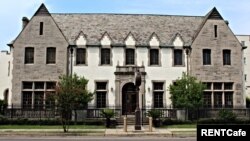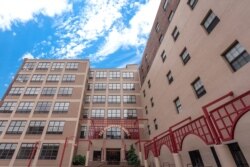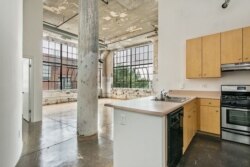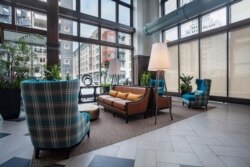Would you like to live in an old funeral home? How about a former asylum for the insane, subway terminal, movie theater or stadium?
These properties, along with abandoned factories, schools, courthouses, churches, warehouses, malls and military installations have been mostly saved from demolition and transformed into apartment complexes.
“They were just magnificent buildings, and rather than have them be torn down and just create a square concrete structure, the idea was to utilize some of the tax credit laws that were in existence at the time and to create these great living spaces,” says Lynn Butts, marketing coordinator at a former chocolate factory-turned-residential complex in Philadelphia.
The former Wilbur Chocolate Company in Philadelphia is now home to the Chocolate Works, a residential apartment complex with one- and two-bedroom units. Part of the appeal of these old buildings is the preserved architectural details.
“When we renovated, we left the interior courtyard structure, so you see these great metal beams going across the courtyard,” Butts says.
In the last 70 years, more than 240,000 apartments came on the market in this way, with 65% of these conversions aimed at mid- and lower-income renters, according to a report from RENTCafe, an internet listing service.
The report finds that the rate of apartment conversions reached an all-time high in the 2010s. Eight hundred old buildings were converted into apartments over the past decade. Almost half, 44%, are geared toward middle- and low-income earners.
“With soaring demand for housing, especially from millennials, many of the large old buildings were repurposed into affordable housing — a great fit for millennials who value sustainable living and do not like to be financially attached to a particular place,” Alexandra Ciuntu, a real estate writer and a research analyst for RENTCafe who also authored the study, told VOA in an email.
Hotels, factories, and schools were the most common structures to be transformed into apartments aimed at mid- and lower-income earners.
“One of the main reasons why adaptive reuse projects can deliver more affordable apartments is that the regulatory process for redeveloping an existing building is easier than that for new construction, especially when there’s no need for changing the footprint or the project’s lot size,” Ciuntu says. “This helps reduce the project’s overall development time, which, in the end, can lead to lower construction costs.”
Butts, marketing coordinator at the former Philadelphia chocolate factory, works for a company that has converted several old buildings, including a car showroom, a factory that used to separate cream from milk, a former hardware store, a former hotel, and a YMCA.
“People are always looking for something that's a little bit different. Our apartments tend to be a lot more spacious, high ceilings, not your typical square white box,” Butts says. “So, many of the properties, for instance, it wouldn't be uncommon to find an exposed brick wall or converted beam ceiling. Some of the characteristics of the former days are left intact.”
Along with charm and sustainability, repurposed properties also meet the increased demand for housing triggered by a growing population, according to Ciuntu. They can also revitalize communities.
“Repurposed old buildings can bring back life to a neighborhood by preserving its unique identity and showcasing its history,” Ciuntu says. “Repurposing an old building also reduces the energy consumption, the amount of building materials, and in the end, the costs associated with demolishing the structure and building a new one in its place.”
The types of buildings that are converted change along with the economic circumstances and trends of the time period, according to the report. From the 1950s until the 1990s, hotels were the most common buildings to be converted. In the 2000s, it was factories. By the 2010s, office buildings were the most likely properties to be transformed into apartments.










